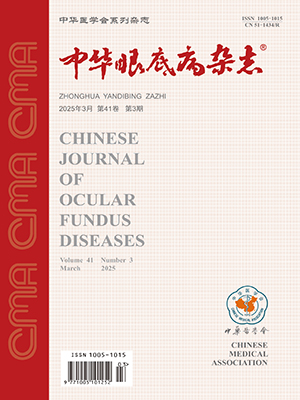| 1. |
Cremers FP, van de Pol DJ, van Kerkhoff LP, et al. Cloning of a gene that is rearranged in patients with choroideraemia[J]. Nature, 1990, 347(6294): 674-677. DOI: 10.1038/347674a0.
|
| 2. |
van den Hurk JA, Schwartz M, van Bokhoven H, et al. Molecular basis of choroideremia (CHM): mutations involving the Rab escort protein-1 (REP-1) gene[J]. Human mutation, 1997, 9(2): 110-117. DOI: 10.1002/(SICI)1098-1004(1997)9:2<110::AID-HUMU2>3.0.CO;2-D.
|
| 3. |
Patrício MI, Barnard AR, Xue K, et al. Choroideremia: molecular mechanisms and development of AAV gene therapy[J]. Expert Opin Biol Ther, 2018, 18(7): 807-820. DOI: 10.1080/14712598.2018.1484448.
|
| 4. |
Heon E, Alabduljalil T, McGuigan Ⅲ DB, et al. Visual function and central retinal structure in choroideremia[J]. Invest Ophthalmol Vis Sci, 2016, 57(9): 377-387. DOI: 10.1167/iovs.15-18421.
|
| 5. |
Shen LL, Ahluwalia A, Sun M, et al. Long-term natural history of visual acuity in eyes with choroideremia: a systematic review and meta-analysis of data from 1004 individual eyes[J]. Br J Ophthalmol, 2021, 105(2): 271-278. DOI: 10.1136/bjophthalmol-2020-316028.
|
| 6. |
Seitz IP, Zhour A, Kohl S, et al. Multimodal assessment of choroideremia patients defines pre-treatment characteristics[J]. Graefe's Arch Clin Exp Ophthalmol, 2015, 253(12): 2143-2150. DOI: 10.1007/s00417-015-2976-4.
|
| 7. |
Roberts MF, Fishman GA, Roberts DK, et al. Retrospective, longitudinal, and cross sectional study of visual acuity impairment in choroideraemia[J]. Br J Ophthalmol, 2002, 86(6): 658-662. DOI: 10.1136/bjo.86.6.658.
|
| 8. |
van Schuppen SM, Talib M, Bergen AA, et al. Long-term follow-up of patients with choroideremia with scleral pits and tunnels as a novel observation[J]. Retina, 2018, 38(9): 1713-1724. DOI: 10.1097/iae.0000000000001844.
|
| 9. |
Edwards TL, Jolly JK, Groppe M, et al. Visual acuity after retinal gene therapy for choroideremia[J]. N Engl J Med, 2016, 374(20): 1996-1998. DOI: 10.1056/NEJMc1509501.
|
| 10. |
Lam BL, Davis JL, Gregori NZ, et al. Choroideremia gene therapy phase 2 clinical trial: 24-month results[J]. Am J Ophthalmol, 2019, 197: 65-73. DOI: 10.1016/j.ajo.2018.09.012.
|
| 11. |
Bozkaya D, Zou H, Lu C, et al. Bilateral visual acuity decline in males with choroideremia: a pooled, cross-sectional meta-analysis[J]. BMC Ophthalmol, 2022, 22(1): 29. DOI: 10.1186/s12886-022-02250-z.
|
| 12. |
Han X, Wu S, Li H, et al. Clinical characteristics and molecular genetic analysis of a cohort of patients with choroideremia[J]. Retina, 2020, 40(11): 2240-2253. DOI: 10.1097/iae.000000 0000002743.
|
| 13. |
Song Y, Chen C, Xie Y, et al. Clinical and genetic findings in a Chinese cohort with choroideremia[J]. Eye (Lond), 2023, 37(3): 459-466. DOI: 10.1038/s41433-022-01950-6.
|
| 14. |
Berson EL, Rosner B, Weigel-DiFranco C, et al. Disease progression in patients with dominant retinitis pigmentosa and rhodopsin mutations[J]. Invest Ophthalmol Vis Sci, 2002, 43(9): 3027-3036.
|
| 15. |
Hariri AH, Ip MS, Girach A, et al. Macular spatial distribution of preserved autofluorescence in patients with choroideremia[J]. Br J Ophthalmol, 2019, 103(7): 933-937. DOI: 10.1136/bjophthalmol-2018-312620.
|




